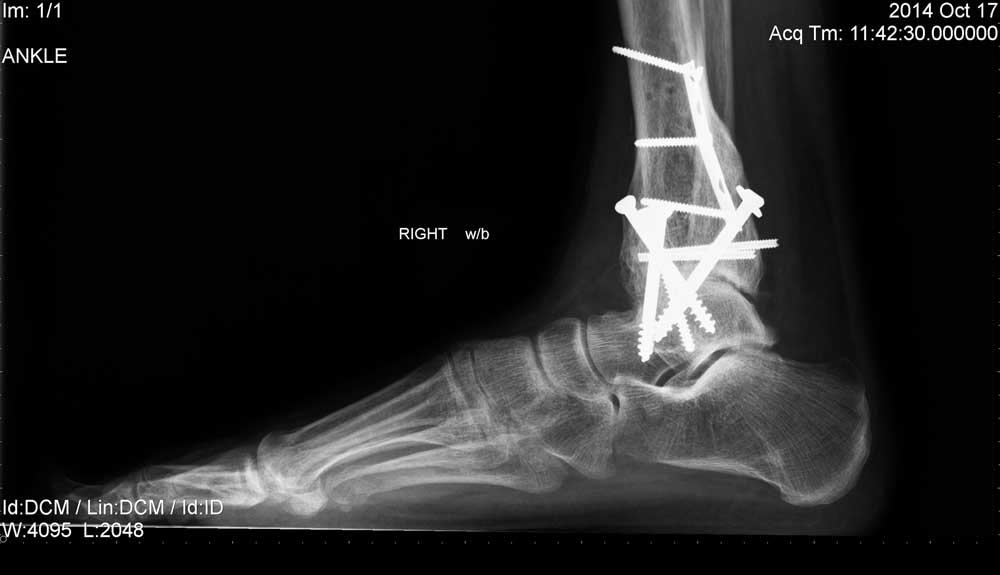How 1 vet lost faith in the VA
Published 12:00 am Saturday, March 21, 2015

- Steve Ringman / The Seattle TimesCoast Guard veteran Tim Kuncl grimaces as he describes VA surgeries that failed to repair his broken leg. BELOW: X-rays showed problems with the surgical hardware in Kuncl’s ankle.
SEATTLE — When Tim Kuncl shattered his shinbone after falling from his Puyallup, Washington, home’s rooftop while hanging Christmas lights in 2011, he trusted that his local Veterans Affairs hospital would return him to health.
But more than three years and three surgeries later, the 45-year-old Coast Guard veteran’s confidence in VA health care has also been smashed.
“It ruined my life,” said Kuncl, a married father of four.
From the get-go, Kuncl’s complicated bone break challenged doctors. Each surgery at the VA Puget Sound Health Care System in Seattle succeeded only in leaving him in escalating pain, Kuncl said. His agony became so intense he could barely control his bladder when he walked.
Last fall, after a VA nurse told him his pain was partly neuropathic — even though X-rays showed problems with surgical hardware — Kuncl finally had had enough. He turned to treatment at a private hospital, where he learned his leg damage left him few options.
Now, with only a stump below one of his knees, Kuncl is recovering from recent amputation surgery while sounding an alarm for other vets.
“I don’t want to see what happened to me happen to anyone else,” said Kuncl, a longtime VA volunteer.
National controversy
Often the object of criticism, VA health care remains under fire in the wake of a national controversy that rocked the federal agency last year.
The waiting-list scandal, which emerged at the VA’s Phoenix hospital, revealed veterans were dying while waiting for medical appointments. Meanwhile, hospital staffers covered up the delays by falsifying records.
In the scandal’s fallout, VA Secretary Eric Shinseki resigned and scrutiny of VA health care intensified nationwide.
A year later, many veterans agree with local VA officials’ assessment that waiting times for appointments at Puget Sound facilities have dropped. Still, some vets and their advocates contend quicker visits are masking deeper problems of understaffing, inexperienced doctors and poor care quality.
“The VA is definitely seeing a larger quantity of people,” said Ann Deutscher, an attorney who handles medical-malpractice cases for veterans. “But they’re not getting the quality of care they need.”
Last year, Congress passed a law to provide $15 billion in new funding for veterans’ health care access. It requires the VA to offer care to veterans from a non-VA provider when VA facilities cannot provide an appointment within 30 days.
Despite the new law, the federal Government Accountability Office last month put the Veterans Health Administration, which oversees 152 VA hospitals and 817 outpatient clinics nationwide, on its list of “high risk” agencies due to “persistent weaknesses” in oversight, training and other areas. The GAO noted that more than 100 previously identified problems with the VHA remain unresolved.
Meanwhile, malpractice claims against the VA have spiked nationally since the April 2014 wait-list scandal, data show. Wrongful-death claims during the second and third quarters of 2014 climbed 43 percent over the same span during 2013. In a letter last month to The Seattle Times, J. Thomas Burch, a lawyer in the agency’s Office of General Counsel, noted the VA paid just 453 malpractice claims total while providing more than 107.8 million patient visits nationwide in 2013.
The small fraction of payouts per visits underscores the VA’s commitment to high quality and safe care, Burch noted.
“Given the inherent risks associated with health care delivery, however, VHA — like all health care providers — does occasionally experience unexpected adverse outcomes in a small percentage of cases,” Burch said.
A challenging fracture
Due to his fall, Kuncl suffered what’s known as a pilon fracture — a relatively rare bone break that can occur after falls from height and be challenging to treat.
Kuncl, who served seven years’ active duty in the Coast Guard during the 1990s, scheduled surgery at the VA’s Seattle hospital on Dec. 27, 2011 — about three weeks after his fall. Surgeons inserted pins, screws and plates to realign his broken tibia.
Over the next year, Kuncl visited the hospital more than three dozen times and saw a variety of caregivers, records show, but his healing progressed slowly. When he finally could walk with a cane, hobbling even a few feet each day left him in agony, he said.
To cope, he relied on VA-prescribed medications, including ibuprofen, Dilaudid and oxycodone. The meds left him sleepless, depressed and addicted, but failed to take away his pain. He drank more and his home life started to unravel.
A year before his injury, Kuncl lost his $90,000-per-year job at a company that trained port workers after he disputed expense reimbursements. With his injury, the role of breadwinner fell to his wife, who worked part time at a children’s clothing store. Meanwhile, Kuncl’s pain kept him from activities he once enjoyed with his kids.
“My family was really suffering,” he said.
When Kuncl’s doctors found bone fragments had broken loose from his still-unhealed bone, they recommended another surgery.
While scheduling it, Kuncl said VA staffers asked what medications he was taking.
“I told them, ‘I’m taking what you guys prescribed to me — ibuprofen,’” he recalled. “And they go, ‘Well, you’re not supposed to be taking that. Ibuprofen inhibits bone growth.’”
In December 2012, VA doctors operated a second time to remove the loose fragments. They also found that two screws meant to stabilize Kuncl’s broken bone “were quite loose,” surgery notes show.
Surgeons removed the old hardware, grafted more bone onto the fracture and inserted new screws and plates to fasten it together. Kuncl underwent several months of physical therapy and eventually started walking again.
“But walking hurt significantly. So, I went back and told them, ‘Something’s wrong.’”
Doctors diagnosed Kuncl with ankle arthritis and recommended yet another surgery. Fusing his ankle and shinbone would limit his ankle mobility but eliminate much of his pain, they said.
In March 2014, VA doctors performing the fusion surgery found that screws inserted during a previous operation “were all broken,” notes in his medical file show. They inserted new screws to compress the bones together, but Kuncl said he soon knew the fusion had failed.
“My pain was 10 times worse than it was before,” he said.
As the months passed, Kuncl had dozens of VA appointments, but the pain persisted. Meanwhile, he finally landed a new job as a port security officer just as the VA discontinued his pain medications. Within two weeks, Kuncl’s pain forced him to resign.
During his final visit to the VA last September, X-rays showed screws were protruding from bone into flesh. A fragmented screw piece or drill bit could be seen abandoned in his ankle. Gaps were visible between the ankle and shinbone, indicating they didn’t fuse.
Still, a doctor who reviewed his X-rays said his “joint is mostly fused,” notes show.
The VA recommended Kuncl schedule another appointment. He contacted a private health care provider instead.
2 choices: amputation or pain
When doctors for the MultiCare Health System in Pierce County reviewed Kuncl’s X-rays last fall, they found the abandoned drill bit embedded against his injured bone.
Another screw had been drilled through a nerve bundle, and bone surfaces were left jagged, making it hard for fusion to occur, interviews and records show.
Dr. Hossein Pakzad, an orthopedic surgeon for MultiCare, declined to comment about the quality of Kuncl’s VA surgeries, saying only: “The fusion surgery was unsuccessful.”
Pakzad gave Kuncl two options: Let him try to repair the failed surgery, or amputate. Even if successful, Pakzad said, the first option likely would mean a lifetime of pain.
“The decision was simple,” Kuncl said.
On Dec. 2, 2014, Pakzad amputated Kuncl’s right leg below the knee. Six weeks later, Pakzad expressed amazement at Kuncl’s quick healing. Still, he said, it would take months before Kuncl could be ready for a prosthetic leg “allowing him to be fully functional again.”
Kuncl now deals mostly with “phantom pain” in a limb that no longer exists. It’s nothing compared to the pain he once endured, he said.
“I’m sad I lost my leg,” he said. “But I’m so much happier now.”
Still, Kuncl said he had options other vets don’t have. During his ordeal, he qualified for Social Security disability, which allowed him to get Medicare that covered private care.
“I’m lucky,” Kuncl said.






